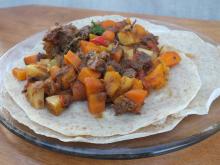For Ardith Frey, injera, a flatbread eaten in northeastern Africa, is a symbol of community. It is served on a large shared platter, along with a sauce. See Ardith’s story at “Injera: A symbol of community.”
Both recipes below are from Extending the Table, Revised Edition. ©2014 by Herald Press, Harrisonburg, VA 22801. Used with permission.
Injera (Ethiopian Flat Bread)
This recipe makes 20 (12-inch / 30-cm) injera.
Mix:
3 cups / 370 ml self-rising flour
½ cup / 125 ml whole wheat flour
½ cup / 125 ml cornmeal, masa harina or barley flour
1 tablespoon / 15 ml active dry yeast
3 ½ cups / 875 ml warm water
Let set in large bowl, covered, an hour or longer, until batter rises and becomes stretchy. When ready, stir batter if liquid has settled on bottom. Then whip in blender, 2 cups/ 500 ml of batter at a time, thinning it with ½ - ¾ cup/ 125-175 ml water. Batter will be quite thin.
Cook in nonstick frying pan without oil over medium or medium-high heat. Use ½ cup / 125 ml of batter per injera for a 12-inch/ 25-cm pan (or 1/3 cup / 75 ml of batter per injera for 10-inch/ 25-cm pan). Pour batter in heated pan and quickly swirl pan to spread batter as thin as possible. Batter should be no thinker than 1/8 inch / 1/3 cm.
Do not turn. It is cooked through when bubbles appear all over top. Lay each injera on a clean towel for a minute or two, then stack in covered dish to keep warm. Finished injera will be thicker than a crepe, but thinner than a pancake.
To serve, overlap a few injera on large platter and place stews on top. Or lay 1 injera on each dinner plate and ladle stew servings on top. Give each person 3 or more injera, rolled or folded in quarters to use for scooping up the stews.
Option 1: Let your batter sit for 3-4 days at room temperature, covered loosely to allow some air, stirring daily. This will produce a sourdough batter.
Option 2: Substitute teff flour for the whole wheat and/or cornmeal, increasing the volume by 2-3 tablespoons / 15-30 ml per substitution.
—Submitted by Mary Jane Wehibe and Blanche Horst
Maraq (Somali Stew)
This receipt serves 8.
In large heavy saucepan, heat:
1-2 tablespoons / 15-30 ml oil
Sauté:
1 pound / 500 stewing beef, cubed
Add and cook 10 minutes over high heat, stirring occasionally:
2 large tomatoes, chopped
Add and continue to cook on high:
1 cup / 250 ml squash, cubed
2-3 okra, sliced
3 carrots, sliced
Approx. ½ cup / 125 ml tomato paste
1 cup / 250 ml water
Add:
1 large potato, sliced or cubed
1 large green pepper, chopped
2-3 cloves garlic, minced
1/3 – 1/2 cup / 75-125 ml cilantro, finely chopped
1 tablespoon / 15 ml salt
1 tablespoon / 15 ml ground cumin
1 cup / 250 ml water or enough for stew consistency
Simmer until meat and vegetables are tender.
Spicy variation: Add hot chili peppers or ground red pepper for a spicier stew.
—Submitted by Asha Sharif Mohammed, Barbara Witmer, Medino Cali and Julia Sensenig



Comments
Great pic, Barb; you must have made Injera and Maraq! Looks great; hope you enjoyed it!
I like the name! What fond memories of Somalia food.
Maraq--where's the goat meat? They should say "substitute beef or chicken."
I make something like this all the time, but not with beef.
Add new comment
Canadian Mennonite invites comments and encourages constructive discussion about our content. Actual full names (first and last) are required. Comments are moderated and may be edited. They will not appear online until approved and will be posted during business hours. Some comments may be reproduced in print.